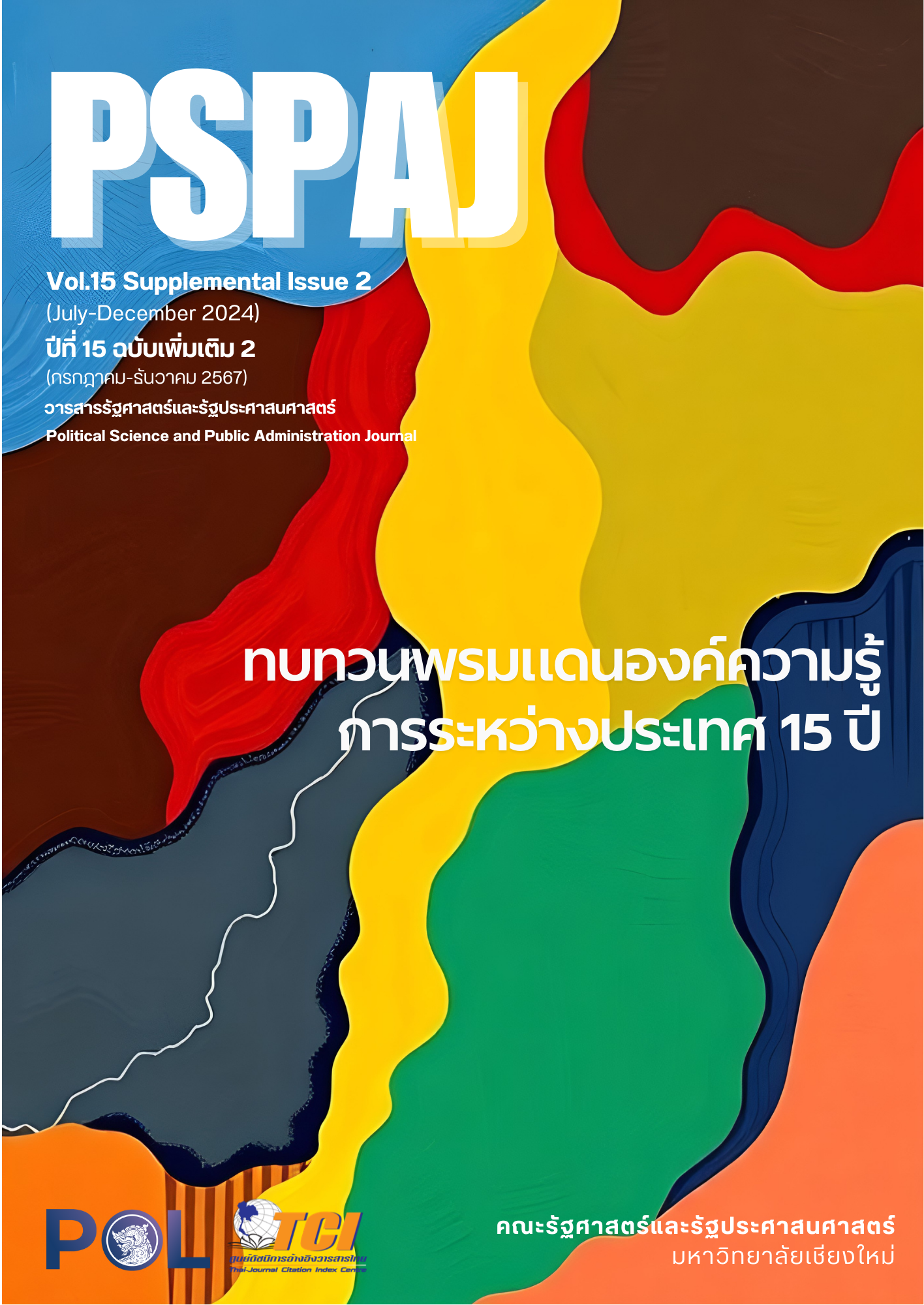Opportunities and Challenges for the Thai Content Industry Penetrating the Japanese Market
Main Article Content
บทคัดย่อ
This paper examines the opportunities and challenges for the Thai content industry in penetrating the Japanese market. The objective is to identify strategic opportunities and unique challenges, focusing on cultural, economic, and market-specific factors. Employing a mixed-methods approach, the study analyzed secondary data on the Japanese entertainment industry and conducted in-depth interviews with key stakeholders. Findings indicate that while Japan's diverse media landscape and growing interest in international content present significant potential, especially for Thai Y-series (BL), the market is highly competitive. Challenges include language barriers, limited distribution channels, and complex regulations. Analysis using Porter's Diamond Model reveals strengths in Thailand's unique cultural offerings and creative talent but highlights weaknesses in market access and coordinated promotion. Recommendations include government-led initiatives fostering cultural exchange and collaborations with Japanese companies, alongside private sector strategies focusing on targeted marketing and subtitling for broader audience reach. A long-term, multifaceted approach is crucial for the Thai content industry to successfully navigate the complexities of the Japanese market and achieve sustainable growth.
Article Details

อนุญาตภายใต้เงื่อนไข Creative Commons Attribution-NonCommercial-NoDerivatives 4.0 International License.
- เนื้อหาและข้อมูลที่ลงตีพิมพ์ในวารสารรัฐศาสตร์และรัฐประศาสนศาสตร์ถือเป็นข้อคิดเห็นและความรับผิดชอบของผู้เขียนบทความโดยตรง ซึ่งกองบรรณาธิการวารสารรัฐศาสตร์และรัฐประศาสนศาสตร์ ไม่จำเป็นต้องเห็นด้วย หรือร่วมรับผิดชอบใดๆ
- บทความและข้อมูล ที่ได้รับการตีพิมพ์ในวารสารรัฐศาสตร์และรัฐประศาสนศาสตร์ ถือเป็นลิขสิทธิ์ของวารสาร หากบุคคลหรือหน่วยงานใดต้องการนำข้อมูลไปใช้ประโยชน์ในทางวิชาการ ขอให้อ้างอิงแหล่งที่มาด้วย
เอกสารอ้างอิง
BBC. (n.d.). Japan Media Guide. Retrieved January 26, 2024, from https://www.bbc.com/news/world-asia-pacific-15217593
Jieping, H., Rijie, C., & Yaqiong, W. (2011). The Research and Progress of Global Digital Content Industry. In Dai, M. (Eds). Innovative Computing and Information (pp. 132-142). Berlin: Springer.
Kersey, J. (n.d). ‘Japan Market Analysis-Key Insights for 2023.’ Humblebunny. Retrieved January 26, 2024, from https://www.humblebunny.com/japan-market-analysis-key-insights-2023/
Lam, D. (2022). Thailand Brings ‘Boys’ Love Back to Japan with Homegrown Dramas. Retrieved March 1, 2024, from https://www.japantimes.co.jp/culture/2022/03/01/tv/thailand-brings-boys-love-back-japan-homegrown-dramas/
Nakamura, K., Asari, T., Ichikawa, Y., Hayashi, K., Yamada, H., & Yamaguchi, S. (2016). Media Ownership and Concentration in Japan. In Noam, E. M. (Ed.). Who Owns the World's Media? Media Concentration and Ownership Around the World (pp. 801-826). New York: Oxford University Press. https://doi.org/10.1093/acprof:oso/9780199987238.003.0026
Nguyen, J. (2023). Japan Group Seeks Manga, Anime Boost. Retrieved January 26, 2024, from from https://www.scmp.com/video/asia/3216598/japans-leading-business-lobby-group-says-anime-manga-key-economic-growth
Pastukhov, D. (2022). ‘Music Market Focus: Japan (Latest Stats, Trends & Analysis).’ Retrieved January 26, 2024, from https://soundcharts.com/blog/japan-music-market-overview
Porter, M. E. (2011). The Competitive Advantage of Nations: Creating and Sustaining Superior Performance. New York: Simon and Schuster.
St. Michel, P. (2023, January 26). What Does 2023 Look Like for J-pop? Retrieved January 26, 2024, from https://www.japantimes.co.jp/culture/2023/01/26/music/2023-look-like-j-pop/
Statista. (n.d.). Media Industry in Japan - Statistics and Facts: Japan. Retrieved January 26, 2024, from https://www.statista.com/topics/7407/media-industry-in-japan/#topicOverview
TMI Associates. (2021). In Brief: Media Law and Regulations in Japan. Retrieved January 26, 2024, from https://www.lexology.com/library/detail.aspx?g=bcd90a0f-ba6d-4831-b5b6-d775b938b75c
Department of industrial Promotion. (2012). Cultural Industry. DIPROM Journal, 54(6), 18-19.
Digital Economy Promotion Agency. (2020). Phon Samruat Khomun Lae Pramoen Sathanaphap Utsahakam, Dichithan, Hon Nathen Pracham Pi 2563, Khatkan Naeonom 3 Pi (Survey and Evaluation on Digital Content Industrial Status for 2020 Outlooks for 3 years). Retrieved January 26, 2024, from https://www.depa.or.th/th/article-view/survey-digital-content-3-ears-since-2563
Hiranpruek, N. (n.d.). Khui Kap Misato Tanaka: Faenkhlap Si Sir Wai Thai lae Phu Pan Nittayasan Lakhon Thai Hai Dang Raboet Nai Yi Pun (Talk with Misato Tanake: Y Series Fanclub and A Creator of Successful Thai Series Magazines in Japan). Retrieved January 26, 2024, from https://adaymagazine.com/misato-tanaka-thai-boys-love/
Jetketkij, J. (2012). Kan Sai Watthanatham Khao Pai Nai Tua Sinkha (Combine Cultures into Products). DIPROM Journal, 54(5), 18-19.
MYAZY. (n.d.). GMMTV Exhibition in Japan! Retrieved January 26, 2024, from https://www.daco-thai.com/gmm-tv-exhibition-in-japan/
Puanperm, S. (2017). Utsahakam Watthanatham Kap Khwam Laklai Khong Watthanatham Kha Wa I: Kha Raek Toe Hen Lo Khit Ti, Kuma mon. (Cultural Industry and Variety of Kawaii Culture: Character of Hello Kitty, Kumamon). JSN Journal, 7(3), 103-112.


